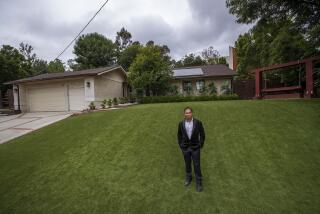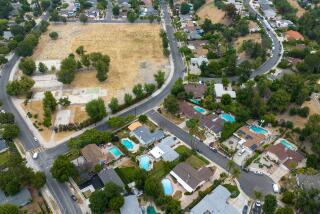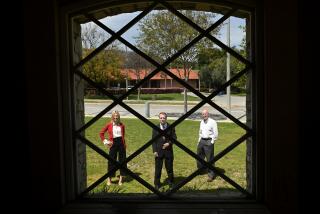Residents See No Quick Fix for Neglected Kadota Area
- Share via
SIMI VALLEY — For some it is a patch of semirural paradise surrounded by the purgatory of suburbia.
For others it is a rat-infested dust bowl, pockmarked with unsightly dumps and rundown properties--the city’s neglected orphan.
And while the Planning Commission approved a land use plan for the Kadota Fig neighborhood earlier this week, few believe anything will change.
That is just fine for Kathy Blackwell, who keeps Ringo, a 15-year-old horse, in a corral behind her house.
“I want to be able to keep my house and my horse and not be forced out,” said Blackwell, who has lived on Fig Street since 1988. “That’s precisely why I moved here. This area is unique and it should be maintained unique.”
But Jim Barlow, a 20-year resident of the area, is fed up with the status quo in Kadota Fig--a neighborhood just east of Simi Valley High School.
“For 20 years this area has gone downhill, while the rest of Simi Valley improved,” Barlow said Wednesday before the city Planning Commission. “This has just gotten worse and worse and worse.”
*
Walking along Cochran Street, the artery that bisects Kadota Fig, Barlow pointed out large empty lots, dilapidated properties, ad hoc dump sites and a dirt road next to his property, which he says is the source of the dust that fills his house and his pool. The city, he said, has promised to improve the unpaved Kadota Street for years.
After years of wrangling among neighbors and between residents and city officials over the appropriate zoning for the neighborhood, planning commissioners gave the green light to a plan that will allow for more homes for each acre and possibly apartment buildings. The plan now goes to the City Council for final approval.
But even planning commissioners, who unanimously voted for the land use plan, said change in the neighborhood will take some time.
“Developers have looked at this site before,” Commissioner Dean Kunicki said. “They are likely to wait.”
Barlow, who said he would like to sell about half of the 2 1/2 acres he owns along Kadota Street, agreed.
“Nothing will happen unless the city helps,” he said. Placing strict limits on the number of homes on each acre and burdening developers with requirements to build sound walls and upgrade streets are sure to keep developers at bay, he said.
The fate of Kadota Fig has been in limbo for nearly a decade. During a citywide planning review in 1988, the City Council recognized the need to update land use plans for the 448-acre area, said Laura Kuhn, a city planner and deputy director of the Department of Environmental Services.
*
Unable to decide what to do with the area of large lots, horse corrals and blossoming fruit trees--but no sidewalks or curbs--the council asked a citizens committee to come up with a set of recommendations for the area. Both Blackwell and Barlow were part of it.
After input from area residents, the committee decided to leave two large sections of Kadota Fig untouched--the area north of the Simi Valley Freeway and the area just north of Leeds Street, Barlow said. The remaining embattled area includes lots on either side of Cochran Street between Fig and Stearns streets.
The committee made a land use recommendation for the area in 1992. After years of fine-tuning, the city prepared an environmental impact report, and a draft zoning plan was presented to the Planning Commission in June. It was a hybrid plan that would have maintained large lots in some areas and allow more intensive building in other areas.
The plan, which would have allowed for a maximum of 478 units over approximately 75 acres, was not satisfactory to those who want to maintain the rural character of the area.
Several residents spoke out against the plan, and the commission recommended that a scaled-down version be considered. The plan approved Wednesday allows for a maximum of 368 units to be built.
Many agree that the lengthy planning process, which the city is responsible for, has been a burden for residents.
“I think the City Council has done a great disservice over the number of years this has been bounced around,” Planning Commissioner Michael Piper said. While well-intentioned, involving residents with competing interest in a prolonged process was a bad decision, he said. “That’s not planning,” Piper added.
Now that the zoning plan is going before the City Council for final approval, area residents are having mixed feelings about the results.
“It’s a good compromise,” said Blackwell, who addressed the commission on behalf of all but one property owner on Fig Street. She can live with the plan as long as high density developments don’t encroach on her backyard, and the trails she takes Ringo on remain protected, she said.
Barlow said a plan--any plan--is better than the current uncertainty landowners have to live with. But he is skeptical Kadota Fig will change any time soon. He wants Kadota Street paved, and the six-acre empty lot east of his house landscaped and developed so that it is no longer a magnet for all-terrain vehicles.
“Hopefully, it will happen before we die,” Barlow said. “That’s our prayer.”
More to Read
Sign up for Essential California
The most important California stories and recommendations in your inbox every morning.
You may occasionally receive promotional content from the Los Angeles Times.










